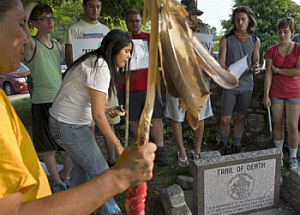 06/06/12 On May 13 thirteen students, an elder and a dog named Willie left Haskell Indian Nations University in Lawrence, Kansas, on a walk to Washington, D. C., to ask the government to stop destroying wetlands and native sacred places.
06/06/12 On May 13 thirteen students, an elder and a dog named Willie left Haskell Indian Nations University in Lawrence, Kansas, on a walk to Washington, D. C., to ask the government to stop destroying wetlands and native sacred places.
The elder is the uncle of Millie Pepion, a junior at Haskell who organized the walk. She submitted her plans to Clinton Global Initiatives (CGI), Chicago, and when it was accepted, she met former President Bill Clinton and talked to him on April 30. The Clinton Global Initiative endorses people who try to effect change in their community in a positive way. He has American and African initiatives and Millie is requesting that he make a Native American Indian initiative. She will present this request to him in person June 8.
Since leaving Kansas, the group has been walking the Potawatomi Trail of Death, the forced removal from northern Indiana to eastern Kansas in 1838. This trail now has over 80 historical markers and many highway signs across 25 counties in Kansas, Missouri, Illinois, and Indiana. Many spiritual blessings have happened to the group as they walk. Towns and communities along the way have opened their hearts to the group, welcoming them with food, water, free camping in parks and backyards.
Every fifth day is set aside for rest or catching up. They have three cars and had to cross the Missouri and Mississippi rivers in cars because no walking is allowed on the huge bridges.
The group entered Indiana on Monday, June 4 where the Williamsport and Attica’s Potawatomi Festival hosted a meal for them and provide free camping at Ouibache Park.
On Tuesday, June 5 they were at West Lafayette, where Purdue’s Native American Cultural Center hosted a dinner and a movie for the group.
Today, June 6 the group will be led by Bill and Shirley Willard to retrace the Trail of Death from Lafayette to Rochester. There will be a carry-in supper at the Fulton County Museum at 6 p.m. The public is welcome; bring two covered dishes and table service. Bill will grill buffalo burgers outside and the Geneva Center will bring canoes for the students to take a ride on the Tippecanoe River at the Trail of Courage. The students will set up their tents and camp the night at the Trail of Courage.
On Thursday, June 7 after breakfast at the Fulton County Museum, they will head north to Marshall County to met Mike Woolfington of Marshall County Tourism. Mike will show them the historical markers and sites known to be the home places of the Potawatomi. At 4 p.m. there will be a public ceremony at Chief Menominee monument.
That night the Trail of Broken Promises walkers will drive to Chicago so they can meet President Clinton early in the morning of June 8. Later that day they will return to Fulton County and camp the night at Bill and Shirley Willard’s 20 acre farm.
The next day June 9 they will resume walking from Fairmount and will attend the Great Lakes Native American Cultural Center’s pow wow at Portland.
The group plans to visit Ball State University’ Native American Center June 10 and then head east to Ohio. Their first night June 11 will be at Greenville where they will be hosted by the Bicentennial Committee for the Treaty of Greenville.
If you are interested in meeting and talking to the students who have taken two months of their young lives to do this long walk, you are welcome to come to any of these activities. You can get a different view from talking to the elder, Millie’s uncle, and pet the dog too.
The Haskell students on the Trail of Broken Promises Walk are getting a broad education on history of the American Indians in the Midwest. Most of them had never heard of the Potawatomi Trail of Death but many of the public were aware of it because of the five caravans traveled by the Potawatomi and friends every five years since 1988. The Haskell students have stopped at nearly every one of the 80 Trail of Death historical markers. All the historical markers were erected with donations at no expense to the taxpayer. Over 30 were erected by Boy Scouts, Girl Scouts, and Cub Scouts.
Millie reported that they also met new people who had not known about the Trail of Death. She said she has been asking the spirits to walk ahead of them and go home with them. She has given water to the spirits, knowing that those on the Trail of Death cried for water as it was a year of terrible drought. At the end of the walk, she will ask the spirits to go up and be “star people.” Millie is Navajo and Blackfoot.
Let’s welcome them to Indiana with traditional Hoosier good will.
By Shirley Willard, Fulton County Historian














